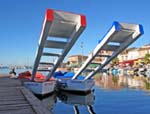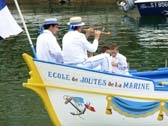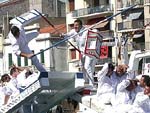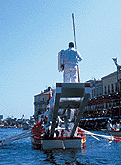
![]() These
jousts take place in the summer - mainly in August - along
the Mediterranean
coast of the Languedoc. They are exactly what the name
suggests, medieval style jousts, but with the jousters mounted
on board boats. They attract large crowds of supporters
and spectators.
These
jousts take place in the summer - mainly in August - along
the Mediterranean
coast of the Languedoc. They are exactly what the name
suggests, medieval style jousts, but with the jousters mounted
on board boats. They attract large crowds of supporters
and spectators.

![]() Such
jousts take place elsewhere in France, but the Languedoc is the undoubted centre
of the sport. Conventions vary from place to place, so the following description
is specifically for the "methode Languedocienne".
Such
jousts take place elsewhere in France, but the Languedoc is the undoubted centre
of the sport. Conventions vary from place to place, so the following description
is specifically for the "methode Languedocienne".
Two substantial wooden boats (barques lourdes) are rowed towards each other by eight or ten oarsmen. They pass each other on the left, much like horses in conventional land jousts.

![]() One
jouster on each boat stands on a special raised platform
(la tintaine) at the stern of the boat about three metres
(10 feet) above the surface of the water.
One
jouster on each boat stands on a special raised platform
(la tintaine) at the stern of the boat about three metres
(10 feet) above the surface of the water.
In addition to the jouster and the rowers, the crew consists of a helmsman (timonier patron) and two musicians, one playing a kind of drum (tambour) and the other a kind of oboe (hautbois). Also on board, under the tintaine, are jousters who will take part in the next joust.

![]()

![]()
![]()

![]()

![]() The
boats themselves are painted red and blue and fly red and blue chequered flags
respectively.
The
boats themselves are painted red and blue and fly red and blue chequered flags
respectively.
To add to the carnival atmosphere the crews sing ancient jousting songs, accompanied by their onboard bands as the boats speed towards each other. As well as the two musicians on board, an on-shore band plays along with events.

![]() Jousters
carry a shield (a bouclier, technically a "pavois") 70 cm high and 40
cm wide, and a lance now 2.8 metres long (before 1920 it was 3 metres long). They
are obliged to wear pure white costumes and white shoes.
Jousters
carry a shield (a bouclier, technically a "pavois") 70 cm high and 40
cm wide, and a lance now 2.8 metres long (before 1920 it was 3 metres long). They
are obliged to wear pure white costumes and white shoes.
A direct hit will propel the unlucky jouster up into air before he falls into the water. The winner is the one (if there is one) remaining on the tintaine after the other has been hoist into the elements.

![]() This
methode Languedocienne is practised in eight towns in the Hérault
département, (Béziers
, Agde,
Marseillan, Mèze, Balaruc, Frontignan, Sète,
and Palavas) and in one town in the Gard
département (Le Grau-du-Roi). Sète boasts no fewer than six
fraternities (Societies) and a jousting school. Mèze and Agde have two
Societies each, the others one each, making a total of 16 in all.
This
methode Languedocienne is practised in eight towns in the Hérault
département, (Béziers
, Agde,
Marseillan, Mèze, Balaruc, Frontignan, Sète,
and Palavas) and in one town in the Gard
département (Le Grau-du-Roi). Sète boasts no fewer than six
fraternities (Societies) and a jousting school. Mèze and Agde have two
Societies each, the others one each, making a total of 16 in all.
The most prestigious event is the jousting tournament de la Saint-Louis held at Sète each 25 August, since 1743. There is now also a French Championship held since 1941 and a French Cup (Coupe de France) held since 1962, with four categories of age and weight (heavy and medium, Seniors and Juniors). There is also a league championship between the 16 Languedoc Societies.
Don't expect much appreciation here of other forms of the sport elsewhere in France, especially the Heath and Safety conscious softies who use extra safe lances, or those neighbouring Provençales who employ motorboats.

![]() In
case you might think that these events have been created
as tourist spectacles, you might be interested to learn
that such jousts have been carried out since ancient times.
Many tournaments have been documented since the fifteenth
century - for example joutes nautiques were laid on for
Napolean on 26th July 1808. The jousting took place on the
River Garonne at Toulouse to celebrate his visit to the
city. Before the fifteenth century, documentation is more
patchy. In 1270 as Louis
IX (now Saint Louis) left for his abortive Crusade to
Egypt, sea-jousts took place at Aigues
Mortes.
In
case you might think that these events have been created
as tourist spectacles, you might be interested to learn
that such jousts have been carried out since ancient times.
Many tournaments have been documented since the fifteenth
century - for example joutes nautiques were laid on for
Napolean on 26th July 1808. The jousting took place on the
River Garonne at Toulouse to celebrate his visit to the
city. Before the fifteenth century, documentation is more
patchy. In 1270 as Louis
IX (now Saint Louis) left for his abortive Crusade to
Egypt, sea-jousts took place at Aigues
Mortes.

![]() A
tournament was recorded in Lyon on 2 June 1177. Sea Jousts
were known all around the Mediterranean
coast, apparently promoted by the Romans (who also liked
jousts in their water-filled amphitheatres). An account
survives of such an event held at Strasbourg in AD 303,
in honour of the great Emperor Diocletian. Before that the
Greeks had been fans of the sport - probably introducing
it to Massalia (modern Marseilles), and before them the
Egyptians were practitioners. Bas reliefs from Egypt (III
to VI dynasties, 2780 to 2380 BC) show nautical jousts,
possibly representing a genuine form of warfare, which look
only marginally more dangerous than the methode Languedocienne.
A
tournament was recorded in Lyon on 2 June 1177. Sea Jousts
were known all around the Mediterranean
coast, apparently promoted by the Romans (who also liked
jousts in their water-filled amphitheatres). An account
survives of such an event held at Strasbourg in AD 303,
in honour of the great Emperor Diocletian. Before that the
Greeks had been fans of the sport - probably introducing
it to Massalia (modern Marseilles), and before them the
Egyptians were practitioners. Bas reliefs from Egypt (III
to VI dynasties, 2780 to 2380 BC) show nautical jousts,
possibly representing a genuine form of warfare, which look
only marginally more dangerous than the methode Languedocienne.
For more information (in French) about Joutes Nautiques in the Languedoc and elsewhere in France, see:
Joutes
Languedociennes www.joutes.com/![]()
Le
site du Pavois d'or (Société de Jouteurs Sétoise) pavoisdor.site.voila.fr/![]()
Fédération
Française de Joutes et de Sauvetage Nautique www.ffjsn.com/![]()






